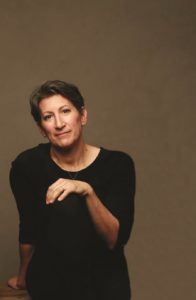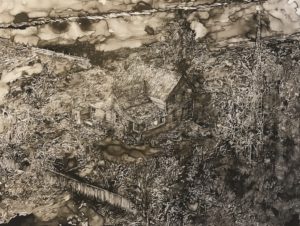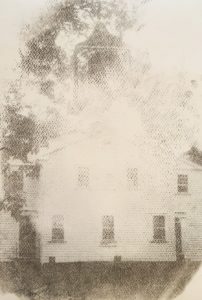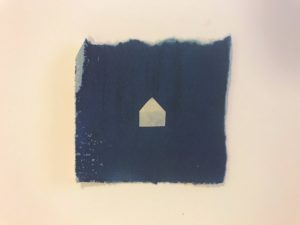“Memory and how we remember, what it looks like … it’s very elusive, very fleeting,” says the artist Elise Kaufman. “So much of what I think about is light and trying to capture its relationship to remembrance.”

Kaufman’s work resides at the crossroads of memory — the way in which our recollection of the past informs our perception of the present, and vice versa. Opening Saturday, June 12 at Off Main Gallery in Wellfleet is “Light Comes First,” a show of recent mixed media works by Kaufman. They appear alongside “Experiments in Watercolor” by Mark Brennan.
Kaufman splits her time between Provincetown, where she has been for the last 29 years, and New York City. She teaches drawing at the Pratt Institute in Brooklyn, where she received her B.F.A. She also holds an M.F.A. from Queens College of the City University of New York.
Kaufman was originally a painting major — and, indeed, there’s still a painterly quality to her work in other mediums. In Field: Ruin Cottage, for instance, an ink drawing on Mylar, there is great attention to the shape and quality of the strokes. A thatched building seems to materialize out of the watery landscape.
While Kaufman’s work combines photography, printmaking, drawing, and collage, it’s at once quietly diverse and remarkably unified. “I’ve been working in lots of different ways — photographically, working with alternative processes, as well as drawing all the time,” says Kaufman. “I think part of it is that I get bored very quickly. I don’t have the same attention span that I used to have. My mind is always jumping.” It’s that attempt to stave off boredom that keeps Kaufman’s work alive even when it feels hushed or reverential under a monochromatic palette.

Kaufman’s photo prints teeter at times towards abstraction, with their stark palette and imagery of buildings in uncluttered landscapes. They have a luminescent quality — slightly ethereal, as if they might slip away at any moment. In Truro Church, for example, the ghostly building seems to fade into the white background. Small and intimate, these works pull you in.
Kaufman doesn’t consider herself a photographer, per se. She hand-coats her own paper with a photosensitive emulsion that she exposes to sunlight. “I’m very sloppy about it because I don’t know how to be precise,” she says, laughing. “That’s just not my sensibility.”

Her work, though intellectual, is also intuitive. “There’s a lot of accident and I’m interested in the opportunity that accident provides,” she says. “Even with these drawings on Mylar, probably the most conventional in the way I can get ink to behave” — she pauses — “but not always. I’m interested in what happens with the ‘not always.’ ”
Kaufman’s cyanotypes, with their distinctive and seductive blue, are something else again. She takes botanical samples and places them on paper brushed with a photosensitive emulsion that turns blue when exposed to sunlight. The flowers and foliage that she chooses are simply “plants that I love to look at,” with beautiful shapes. They feel specimen-like, samples frozen in time.
The photographic work, including the cyanotypes, are a relatively quick and gratifying foil to Kaufman’s ink drawings of houses, high-rises, and other structures. “My drawings are very, very labored,” she says. “I’m working on them for a long, long time. The photography offers me this great respite. It’s so immediate.”

Rhythmic and compulsive, these drawings are packed with detail set against broad abstract washes of ink that appear to sit on the surface of the Mylar. The absence of figures is purposeful, says Kaufman: “I’m interested in the vacancy of space, and working without the figure helps the viewer put themselves into the work. It helps provide the opportunity to view things in a more detached way. Once the figure arrives, the privacy of communion is interrupted.”
For Kaufman, the formalities of the work — the fading and coalescing of form — are really about the content of the work, about recalling the past in an attempt to “fix” it in place. This “tugging” between the viewer and scene, between the past and present, “touches on something universal,” she says. “I’m just trying to catch it, that elusiveness and that unique imprint from one person.”
Let There Be Light
The event: “Light Comes First,” a show of works by Elise Kaufman
The time: Saturday, June 12 through July 3; Friday, Sunday, and Monday, noon to 6 p.m.; Saturday, 2 to 8 p.m.; opening reception Saturday at 6 p.m.
The place: Off Main Gallery, 75 Commercial St. in Wellfleet
The cost: Free



